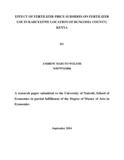| dc.description.abstract | Kenya, a country in the East African region lies across the equator and covers approximately
582,366 square kilometers. Three quarters of the country lies in the arid and semi arid lands and
waste lands in the north and North Eastern regions. The arid and semi arid often experience dry
spells leading to prolonged drought.
As per the 2009 national census, Kenya’s population was 37.7million up from an approximate
35.8 million in 2007 and was projected to reach 44,2million in 2013. The poverty level was
estimated at 45.9% as at 2006
Kenya is divided into forty seven counties of which Bungoma County is the third largest with a
population of 1,630,934 and a population density of 454 people per km2. The County is one of
the main producers of Maize in Kenya.
With the high poverty in the country as mentioned above, efforts to eradicate extreme poverty
and hunger have been initiated though various challenges stand against the efforts; for example
poor agronomic practices, low coverage of extension services and affordability of appropriate
technologies like fertilizers and hybrid seeds, low value addition, adverse climate changes
leading to frequent and intense droughts, floods, re-emergence of diseases and pests.
To address increased use of fertilizer which is one of the important technologies needed for
increased productivity, the study used panel data of farmers from Kabuyefwe location which was
part of the larger Naitiri in Bungoma County, to study the effects of fertilizer subsidy on
fertilizeruse. A simple regression model was employed in the study.
Results from the study indicated that the cost of fertilizer, weather patterns and availability of
alternatives to fertilizer all had negative effect on fertilizer use, whereas farmer’s knowledge,
availlabity of fertilizer at the right time and quantity, land size and the price of the previous crop all had positive effect on use of fertilizer.
The study results further indicated that the factors considered were responsible for 89.82% of the variations in the fertilizer use. The probability (p<0.045) realized affirmed the reliability of results generated from the study.
The study recommended the Government not to pursue further lowering of fertilizer prices
through subsidies because at the price at which farmers were buying subsidized fertilizer, the
cost of fertilizer was no longer a very important factor affecting fertilizer use, rather, weather
patterns, land size, knowledge of farmers were of more effects to fertilizer use.
Given the various issues arising, the study recommended further studies on minimum divisible
land size that will ensure high use of fertilizer and another study on advantages and
disadvantages of the effects of using alternatives to fertilizer. | en_US |

